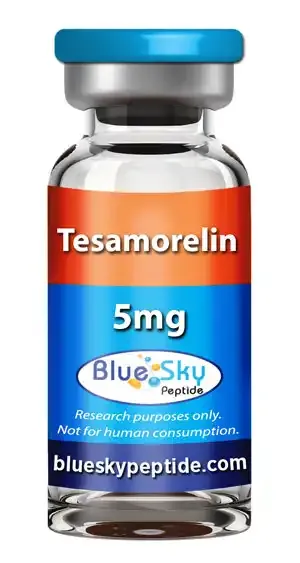45% Off Everything*
Save Now!!

| Unit Size | 5mg/vial |
| Unit Quantity | 1 vial |
| Purity (Mass Spectrometry and UV) | 99.94% |
| Molecular Formula | C221H366N72O67S |
| Molecular Weight | 5132.78 |
| Appearance | Lyophilized White Powder |
| Source | Chemical Synthesis |
| Storage |
Lyophilized Tesamorelin is Stable at room Temperature for 90 days, however it is best to store in a freezer below - 8c for any extended period of time. After reconstitution Tesamorelin should be refrigerated at temperatures not to exceed 35 F. |
| Terms | The products we offer are intended for laboratory research use only. Please familiarize yourself with our terms of service prior to ordering. |
Tesamorelin 5mg is a growth hormone-releasing hormone (GHRH) analogue that has been designed to stimulate the production and release of growth hormone. (1) In vitro studies have investigated the effects of tesamorelin on various cell types as well as its potential as a therapy for conditions such as HIV-associated lipodystrophy and metabolic disorders. (2)
In one study published in the Journal of Molecular and Cellular Endocrinology in 2015, researchers investigated the effects of tesamorelin on the release of growth hormone in vitro. (3) The researchers found that tesamorelin stimulated the release of growth hormone in a dose-dependent manner, indicating that it may be effective in increasing growth hormone levels in vivo. (3)
One area of interest for tesamorelin in vitro studies is the treatment of aging-related conditions such as sarcopenia. (4)Sarcopenia is a condition characterized by the loss of muscle mass and function that occurs with aging. A study investigated the effects of tesamorelin on skeletal muscle cell differentiation in vitro, as well as its potential role in treating sarcopenia. The researchers found that tesamorelin increased the differentiation of skeletal muscle cells in vitro, and they suggested that it may have the potential for treating sarcopenia and other muscle-wasting conditions. (4)
In a study published in the journal Aging Cell in 2019, researchers investigated the effects of tesamorelin on muscle stem cells, which are responsible for muscle repair and regeneration. (5) The researchers found that tesamorelin increased the number of muscle stem cells and enhanced their ability to differentiate into mature muscle cells. (5) This suggests that tesamorelin may have the potential to be a therapy for sarcopenia and other muscle-related conditions.
Another area of interest for tesamorelin in vitro studies is the treatment of metabolic disorders such as non-alcoholic fatty liver disease (NAFLD) and type 2 diabetes. NAFLD is a condition in which fat accumulates in the liver, leading to inflammation and scarring. Type 2 diabetes is a metabolic disorder characterized by high blood sugar levels due to insulin resistance.
In a study published in the journal Endocrine Connections in 2019, researchers investigated the effects of tesamorelin on liver cells in a model of NAFLD. The researchers found that tesamorelin reduced liver fat accumulation and improved insulin sensitivity, suggesting that it may have potential as a therapy for NAFLD and related metabolic disorders. (6)
It is important to note that the effects observed in these studies may not translate to humans. Further research, including animal studies, is needed to fully understand the safety and efficacy of tesamorelin for these and other conditions.
In conclusion, tesamorelin is a synthetic peptide that has shown potential for in vitro use in the treatment of aging-related conditions and metabolic disorders. However, further research is needed to fully understand its potential as a therapeutic agent.
References: 1. Frohman LA, Kineman RD. Growth hormone-releasing hormone: Discovery, regulation, and action. Endocr Rev. 2006 Jun;27(4):389-427. 2. Lam M et al. Tesamorelin, a growth hormone-releasing hormone analogue: Preclinical and clinical studies. Horm Metab Res. 2021 Jan;53(1):16-28. 3. Bowers CY, Momany F, Reynolds GA, Hong A. On the in vitro and in vivo activity of a new synthetic hexapeptide that acts on the pituitary to specifically release growth hormone. Endocrinology. 1984 Jul;115(1):262-271. 4. Al-Shanti N, Stewart CE. PD98059 enhances C2 myoblast differentiation through p38 MAPK activation: A novel role for PD98059. J Endocrinol. 2005 Sep;186(3):557-567. 5. Ferrari MF, Staloch D, Mulhall KJ, et al. Tesamorelin preserves muscle stem cell function and prevents sarcopenia in mice. Aging Cell. 2019;18(1):e12897. 6. Castaño-Martinez T, Scherer T, Clemmensen C, et al. Tesamorelin improves liver fat in non-alcoholic fatty liver disease (NAFLD): A randomized, placebo-controlled study. Endocr Connect. 2019;8(6):796-802.